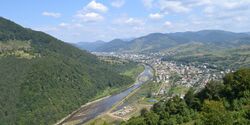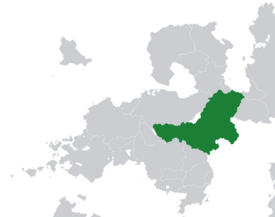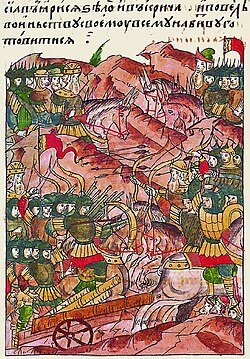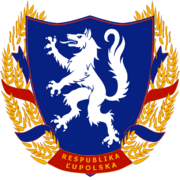Luepola: Difference between revisions
No edit summary |
No edit summary |
||
| Line 121: | Line 121: | ||
}} | }} | ||
'''Luepola''' ({{IPA-en|luˈpoʊlə|}}, {{lang-lupl|Ľupola}} {{IPAc-lupl|lj|u|'|p|o|l|a}}), officially the '''Republic of Luepola''' ({{lang-lupl|Respublika Ľupolska}} {{IPAc-lupl|[]|r|e|s|'|p|u|b|l|i|k|a|-|lj|u|'|p|o|l|s|k|a}}), is a federal parliamentary republic located in eastern [[Patyria]]. It is divided into | '''Luepola''' ({{IPA-en|luˈpoʊlə|}}, {{lang-lupl|Ľupola}} {{IPAc-lupl|lj|u|'|p|o|l|a}}), officially the '''Republic of Luepola''' ({{lang-lupl|Respublika Ľupolska}} {{IPAc-lupl|[]|r|e|s|'|p|u|b|l|i|k|a|-|lj|u|'|p|o|l|s|k|a}}), is a federal parliamentary republic located in eastern [[Patyria]]. It is divided into fourteen {{wp|Oblast|voblasts}} and two federal municipalities. Luepola covers a total of 821,700 square kilometers, making it the largest nation in Patyria, and has a population of 79,406,594, making it the second most populous nation in Patyria after [[Vierzland]]. Luepola's capital is [[Prishek]], and its largest city is [[Voitz]]. Other notable Luepolan cities include [[Rostva]], [[Pomorna]], [[Hrdovna]], [[Zvin]], [[Grast]], and [[Utrna]]. | ||
Luepola is bordered to the north by [[Vyzinia]], [[Plosenia]], and the [[Gulf of St. Jan]]; to the east by [[Tanavia]], [[Vorochia]], and the [[Oriental Sea]]; to the south by [[Zacotia]] and [[Granzery]]; and to the west by [[Lairea]] and Vierzland. | Luepola is bordered to the north by [[Vyzinia]], [[Plosenia]], and the [[Gulf of St. Jan]]; to the east by [[Tanavia]], [[Vorochia]], and the [[Oriental Sea]]; to the south by [[Zacotia]] and [[Granzery]]; and to the west by [[Lairea]] and Vierzland. | ||
| Line 152: | Line 152: | ||
On 8 April 1942, [[Invasion of Zacotia|invasion of Zacotia]] in order to install a Communist government. Vierzland and Savland each declared war on Luepola in turn, beginning the [[Great War (Vasarden)|Great War]]. After a poorly-prepared Vierz invasion of Luepola failed, Luepola went on the offensive, bringing Apelia and Granzery into the war as members of the [[Socialist International Coalition]] and besieging Vierzland on all of its land borders while also invading southern Patyria, annexing the region alongside Granzery and similarly laying siege to Cestros. Intermittent Coalition air raids on Vierzland escalated into full-scale [[Strategic Bombing in the Great War (Vasarden)|strategic]] and {{wp|terror bombing}} campaigns which were later reciprocated by the [[Allianz (Vasarden)|Allied nations]]; one of the most notable such air raids was the [[Bombing of Talheim]], in which the use of {{wp|chemical weapons}} killed tens of thousands in the deadliest week of the war. Shortly after, the Luepolans initiated the [[Battle of Kasenberg]], the largest single battle of the war. Nonetheless, Luepola's efforts at overrunning Vierzland's and Cestros's defensive lines were unsuccessful, and the entry of [[Vonzumier]] into the war placed increased pressure on Luepola's southern front and forcing her to defend her colonial holdings. Decisive defeats inflicted on Luepola at Kasenberg, [[Battle of Tarphos|Tarphos]], and the [[Battle of the Verakoni Gap|Verakoni Gap]] forced Luepola on the defensive, but Luepola was nonetheless able to maintain its own defensive line close within its pre-war borders until fall 1947, when the Allied [[Operation Rapture]] forced Apelia's surrender. In the final six months of the war, Luepola found itself overwhelmed as Vonzumier and Vierzland mounted a final offensive against Luepola. After the death of Marusić, acting Chairman [[Saňin Mlakar]] ordered the surreder of Luepola to the Vierz army, effectively ending the war. The [[Treaty of Adtrus]] would later dissolve the Luepolan communist government, place Luepola's satellite republics in Oridia under Vierz administration, and subject Luepola to military occupation by Vierzland. | On 8 April 1942, [[Invasion of Zacotia|invasion of Zacotia]] in order to install a Communist government. Vierzland and Savland each declared war on Luepola in turn, beginning the [[Great War (Vasarden)|Great War]]. After a poorly-prepared Vierz invasion of Luepola failed, Luepola went on the offensive, bringing Apelia and Granzery into the war as members of the [[Socialist International Coalition]] and besieging Vierzland on all of its land borders while also invading southern Patyria, annexing the region alongside Granzery and similarly laying siege to Cestros. Intermittent Coalition air raids on Vierzland escalated into full-scale [[Strategic Bombing in the Great War (Vasarden)|strategic]] and {{wp|terror bombing}} campaigns which were later reciprocated by the [[Allianz (Vasarden)|Allied nations]]; one of the most notable such air raids was the [[Bombing of Talheim]], in which the use of {{wp|chemical weapons}} killed tens of thousands in the deadliest week of the war. Shortly after, the Luepolans initiated the [[Battle of Kasenberg]], the largest single battle of the war. Nonetheless, Luepola's efforts at overrunning Vierzland's and Cestros's defensive lines were unsuccessful, and the entry of [[Vonzumier]] into the war placed increased pressure on Luepola's southern front and forcing her to defend her colonial holdings. Decisive defeats inflicted on Luepola at Kasenberg, [[Battle of Tarphos|Tarphos]], and the [[Battle of the Verakoni Gap|Verakoni Gap]] forced Luepola on the defensive, but Luepola was nonetheless able to maintain its own defensive line close within its pre-war borders until fall 1947, when the Allied [[Operation Rapture]] forced Apelia's surrender. In the final six months of the war, Luepola found itself overwhelmed as Vonzumier and Vierzland mounted a final offensive against Luepola. After the death of Marusić, acting Chairman [[Saňin Mlakar]] ordered the surreder of Luepola to the Vierz army, effectively ending the war. The [[Treaty of Adtrus]] would later dissolve the Luepolan communist government, place Luepola's satellite republics in Oridia under Vierz administration, and subject Luepola to military occupation by Vierzland. | ||
===Vierz Occupation and the State of Luepola (1948- | ===Vierz Occupation and the State of Luepola (1948-1977)=== | ||
{{main||Reichskommissariat Luepola (1949-1952)|State of Luepola|}} | {{main||Reichskommissariat Luepola (1949-1952)|State of Luepola|}} | ||
===Luepolan | ===Luepolan Spring (1977-1985)=== | ||
{{main|Luepolan | {{main|Luepolan Spring}} | ||
===Second Republic of Luepola (1985-Present)=== | ===Second Republic of Luepola (1985-Present)=== | ||
==Geography== | ==Geography== | ||
[[File:LuepolanCountryside.jpg|thumbnail|250px| | {{main|Geography of Luepola}} | ||
Luepola is a relatively large country, covering 821,700 square kilometers and securing its position as the largest country in Patyria, followed by neighboring Vierzland. Luepola has a largely temperate climate overall, though the southern coastal regions of the country receive quite warm temperatures, and the mountainous western | [[File:LuepolanCountryside.jpg|thumbnail|250px|Kutra, a town nestled in one of the many valleys of [[Vlahac]].]] | ||
<!-- Luepola is a relatively large country, covering 821,700 square kilometers and securing its position as the largest country in Patyria, followed by neighboring Vierzland. Luepola has a largely temperate climate overall, though the southern coastal regions of the country receive quite warm temperatures, and the mountainous western stretches of the country experiencing a cold, alpine climate for much of the year.--> | |||
===Climate=== | |||
===Biodiversity=== | |||
==Demographics== | ==Demographics== | ||
===Population=== | |||
===Ethnic Groups=== | |||
===Languages=== | |||
{{see also|Luepolan language}} | |||
===Religion=== | |||
===Health=== | |||
===Education=== | |||
===Urbanization=== | |||
{{Largest Luepolan Cities}} | {{Largest Luepolan Cities}} | ||
{{ | ==Politics== | ||
===Constitution of Luepola=== | |||
{{main|Constitution of the Republic of Luepola}} | |||
=== | ===Government and the Sliet=== | ||
{{main|Sliet}} | |||
===Law Enforcement=== | |||
===Foreign Relations=== | |||
{{main|Foreign Relations of Luepola}} | |||
===Armed Forces=== | |||
{{main|Luepolan Armed Forces}} | |||
==Culture== | |||
===Art=== | |||
===Literature=== | |||
===Music=== | |||
=== | ===Television and Cinema=== | ||
===Sport=== | |||
===Cuisine=== | |||
{{main|wikipedia:Polish Cuisine{{!}}Luepolan Cuisine}} | |||
<!-- | |||
The Luepolan government consists of three branches: the [[Sliet]], which is the legislative body of Luepola, and the branch which the Prime Minister is formally a member of; the Executive branch, which is composed of the President, Vice President, cabinet, and most government agencies; and the Luepolan High Court, which is the highest judiciary body in the nation. | The Luepolan government consists of three branches: the [[Sliet]], which is the legislative body of Luepola, and the branch which the Prime Minister is formally a member of; the Executive branch, which is composed of the President, Vice President, cabinet, and most government agencies; and the Luepolan High Court, which is the highest judiciary body in the nation. | ||
| Line 201: | Line 227: | ||
The High Court is the supreme judiciary body of the nation, and handles civil and criminal cases that have been sucessfully appealed past all regional courts. The High Court also rules on the constitutionality of a law passed by the Sliet, and is in charge of handling impeachment cases. Judges are appointed by the President and approved by the Assembly, and may serve for a maximum of thirty years, though these terms may be cut short by voluntary retirement or death. A judge can be removed prior to their term expiration through impeachment by the Popular Assembly; a special session of the Great Assembly is then convened to convict an impeached judge, or to strike down the impeachment. | The High Court is the supreme judiciary body of the nation, and handles civil and criminal cases that have been sucessfully appealed past all regional courts. The High Court also rules on the constitutionality of a law passed by the Sliet, and is in charge of handling impeachment cases. Judges are appointed by the President and approved by the Assembly, and may serve for a maximum of thirty years, though these terms may be cut short by voluntary retirement or death. A judge can be removed prior to their term expiration through impeachment by the Popular Assembly; a special session of the Great Assembly is then convened to convict an impeached judge, or to strike down the impeachment. | ||
{{Gallery | {{Gallery | ||
|title= | |title= | ||
| Line 219: | Line 244: | ||
|The floor of the Popular Assembly. | |The floor of the Popular Assembly. | ||
}} | }} | ||
--> | |||
Revision as of 19:16, 3 April 2020
This article is incomplete because it is pending further input from participants, or it is a work-in-progress by one author. Please comment on this article's talk page to share your input, comments and questions. Note: To contribute to this article, you may need to seek help from the author(s) of this page. |
Republic of Luepola Respublika Ľupolska | |
|---|---|
| Motto: Narod i Sloboda Naviek Nation and Freedom Forever | |
| Anthem: Marš Lémanki March of the Lémanites | |
Location of Luepola | |
| Capital | Prishek |
| Largest city | Voitz |
| Official languages | Luepolan |
| Recognised regional languages | |
| Ethnic groups (2018) | Luepolan Molves 82% Non-Luepolan Molves 12% Njataris 3% Vierz 2% Other 1% |
| Religion | Orthodoxy |
| Demonym(s) | Luepolan |
| Government | Federal semi-presidential republic |
• President | Savo Grigorević |
• Vice President | Anastasi Obrádović |
• Prime Minister | Radovan Kozić |
| Legislature | Sliet |
| Great Assembly Veliki Sbor | |
| Popular Assembly Ľudovi Sbor | |
| Establishment | |
• Unification of Varadna and Strentland | 4 August 1329 |
| 10 July 1390 | |
| 13 March 1979 | |
• Official Establishment | 1 January 1981 |
| 8 July 1985 | |
| Area | |
• Total | 821,700 km2 (317,300 sq mi) |
| Population | |
• 2019 estimate | 79,406,594 |
• Density | 96.6/km2 (250.2/sq mi) |
| GDP (PPP) | 2019 estimate |
• Total | $2,185,348,873,474 (2.1 trillion) |
• Per capita | $27,521 |
| GDP (nominal) | 2019 estimate |
• Total | $1,798,559,354,100 (1.8 trillion) |
• Per capita | $22,650 |
| Gini | 29.1 low |
| HDI | 0.845 very high |
| Currency | Luepolan Grivna (Ғ) (LG) |
| Time zone | UTC+2 |
| Date format | dd.mm.yyyy |
| Driving side | right |
| Calling code | +52 |
| Internet TLD | .lu |
Luepola (/luˈpoʊlə/, Ľupola [ʎuˈpɔla]), officially the Republic of Luepola (Respublika Ľupolska [ɾesˈpublika ʎuˈpɔlska]), is a federal parliamentary republic located in eastern Patyria. It is divided into fourteen voblasts and two federal municipalities. Luepola covers a total of 821,700 square kilometers, making it the largest nation in Patyria, and has a population of 79,406,594, making it the second most populous nation in Patyria after Vierzland. Luepola's capital is Prishek, and its largest city is Voitz. Other notable Luepolan cities include Rostva, Pomorna, Hrdovna, Zvin, Grast, and Utrna.
Luepola is bordered to the north by Vyzinia, Plosenia, and the Gulf of St. Jan; to the east by Tanavia, Vorochia, and the Oriental Sea; to the south by Zacotia and Granzery; and to the west by Lairea and Vierzland.
History
Prehistory
Pre-Unification (until 1329)
Varadna-Strentland and the founding of Luepola (1329-1390)
The Kingdom of Luepola, then known as Varadna-Strentland, was established in 1329 by Genadi I of Strentland. Genadi's wife Vladislava I was the heir apparent to the throne of Varadna; upon her coronation, their son became the heir to both thrones, and Vladislava opted to instead cede control of Varadna to Genadi, unifying the two countries ahead of schedule.
A period of turmoil followed, as the newly unified country was torn into civil war by the two separate houses of nobility backing different successors following the death of Genadi the Lesser. Princess Cvieta I, the preferred heir by the Varadian nobility, emerged victorious from the war. Shortly after the end of the war, neighboring kingdoms Plosenia and Zacotia invaded Varadna-Strentland, initiating the Containment Wars, in which Varadna-Strentland allied Vyzinia to retake its territory and eventually partition Plosenia and annex significant parts of Zacotia. The victory was followed by the declaration of the Kingdom of Luepola as the successor to Varadna-Strentland.
Kingdom of Luepola (1390-1818)
First Luepolan Republic (1818-1901)
People's Republic of Luepola (1901-1948)

The People's Republic of Luepola was officially declared by Lev Gincburg after likely illegitimately winning his re-election as the President of Luepola. The declaration was followed by the relatively quick and violent transformation of Luepola into a one-party socialist state. The Communist Party used its stranglehold over the country to eliminate political opponents and dissidents, hasten Luepola's relatively slow industrialization, reform the Luepolan language and script, and export its ideology to other nations. Countries such as Vorochia, Granzery, Poicary and Apelia fell sway to communism throughout the first half of the 20th century. Luepola transformed its colonial holdings in Oridia and Tusola into socialist republics, but effectively maintained a stranglehold on their state affairs.
On 8 April 1942, invasion of Zacotia in order to install a Communist government. Vierzland and Savland each declared war on Luepola in turn, beginning the Great War. After a poorly-prepared Vierz invasion of Luepola failed, Luepola went on the offensive, bringing Apelia and Granzery into the war as members of the Socialist International Coalition and besieging Vierzland on all of its land borders while also invading southern Patyria, annexing the region alongside Granzery and similarly laying siege to Cestros. Intermittent Coalition air raids on Vierzland escalated into full-scale strategic and terror bombing campaigns which were later reciprocated by the Allied nations; one of the most notable such air raids was the Bombing of Talheim, in which the use of chemical weapons killed tens of thousands in the deadliest week of the war. Shortly after, the Luepolans initiated the Battle of Kasenberg, the largest single battle of the war. Nonetheless, Luepola's efforts at overrunning Vierzland's and Cestros's defensive lines were unsuccessful, and the entry of Vonzumier into the war placed increased pressure on Luepola's southern front and forcing her to defend her colonial holdings. Decisive defeats inflicted on Luepola at Kasenberg, Tarphos, and the Verakoni Gap forced Luepola on the defensive, but Luepola was nonetheless able to maintain its own defensive line close within its pre-war borders until fall 1947, when the Allied Operation Rapture forced Apelia's surrender. In the final six months of the war, Luepola found itself overwhelmed as Vonzumier and Vierzland mounted a final offensive against Luepola. After the death of Marusić, acting Chairman Saňin Mlakar ordered the surreder of Luepola to the Vierz army, effectively ending the war. The Treaty of Adtrus would later dissolve the Luepolan communist government, place Luepola's satellite republics in Oridia under Vierz administration, and subject Luepola to military occupation by Vierzland.
Vierz Occupation and the State of Luepola (1948-1977)
Luepolan Spring (1977-1985)
Second Republic of Luepola (1985-Present)
Geography

Climate
Biodiversity
Demographics
Population
Ethnic Groups
Languages
Religion
Health
Education
Urbanization
| Largest cities of Luepola (2019 census) | |||||||||
|---|---|---|---|---|---|---|---|---|---|
| City | Population | State | City | Population | State | ||||
| 1 | Voitz | 2,364,964 | Občina Vojc | 11 | Bráznica | 595,788 | Aneska | ||
| 2 | Rostva | 1,512,376 | Jutska | 12 | Elenevo | 581,393 | Jutska | ||
| 3 | Prishek | 948,083 | Hautbecirk | 13 | Čakajec | 560,848 | Bružka | ||
| 4 | Zvin | 713,555 | Varadna | 14 | Aneska | 557,854 | Aneska | ||
| 5 | Grast | 704,721 | Trnava | 15 | Voľana | 547,967 | Varadna | ||
| 6 | Kořevac | 687,397 | Trnava | 16 | Nediňe | 539,901 | Bosunija | ||
| 7 | Bosaňe | 664,919 | Dvolăn | 17 | Mlaževo | 500,608 | Varadna | ||
| 8 | Hrdovna | 655,083 | Sevierna | 18 | Đalan | 488,226 | Nimorăn | ||
| 9 | Utrna | 644,323 | Bosunija | 19 | Judusa | 472,475 | Bosunija | ||
| 10 | Pomorna | 638,575 | Jutska | 20 | Obránse | 470,273 | Cărnipoře | ||
Politics
Constitution of Luepola
Government and the Sliet
Law Enforcement
Foreign Relations
Armed Forces
Culture
Art
Literature
Music
Television and Cinema
Sport
Cuisine








